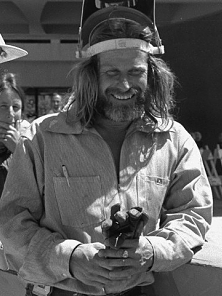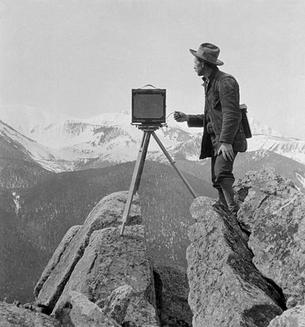
Bozeman is a city in and the county seat of Gallatin County, Montana, United States. Located in southwest Montana, the 2020 census put Bozeman's population at 53,293 making it the fourth-largest city in Montana. It is the principal city of the Bozeman, Montana, Micropolitan Statistical Area, consisting of all of Gallatin County with a population of 118,960. It is the fastest growing micropolitan statistical area in the United States in 2018, 2019 and 2020, as well as the second-largest of all Montana's statistical areas.
The Albert Einstein Memorial is a monumental bronze statue by sculptor Robert Berks, depicting Albert Einstein seated with manuscript papers in hand. It is located in central Washington, D.C., United States, in a grove of trees at the southwest corner of the grounds of the National Academy of Sciences at 2101 Constitution Avenue N.W., near the Vietnam Veterans Memorial. Two replicas exist at the Israel Academy of Sciences and Humanities and the Georgia Institute of Technology.

John Merin Bozeman was a pioneer and frontiersman in the American West who helped establish the Bozeman Trail through Wyoming Territory into the gold fields of southwestern Montana Territory in the early 1860s. He helped found the city of Bozeman, Montana, in 1864, which is named for him.

Marco Polo di Suvero, better known as Mark di Suvero, is an abstract expressionist sculptor and 2010 National Medal of Arts recipient.

Robert Berks was an American sculptor, industrial designer and planner. He created hundreds of bronze sculptures and monuments including the Mary McLeod Bethune Memorial, and the Albert Einstein Memorial in Washington, D.C. Bob was prolific and created numerous sketches, drawings, and paintings; often in service of sculpture and site-planning subjects. He worked for over 50 years in a converted schoolhouse on the north fork of Long Island, NY. For projects with living subjects, Bob would often invite individuals to visit with he and Tod for a period of a week or two so he could observe them in real life; through this time he captured emotions, tendencies, facial expressions, and body language. It was this commitment to understanding his subject below the surface that facilitated the intimacy and personality found in his sculptural portraits. Bob's work is spread around the world, but he is best known for his commissions in Washington DC. Bob is one of the only artists in the world to have multiple pieces regularly on display in the Oval office. Depending on the desires of the sitting US President, Berks' busts of famed civil servants and civil rights leaders line the walls of the Oval ; most often on view are busts of FDR, Lincoln, RFK, Ronald Reagan, and JFK.

Deborah Kay Butterfield is an American sculptor. Along with her artist-husband John Buck, she divides her time between a farm in Bozeman, Montana, and studio space in Hawaii. She is known for her sculptures of horses made from found objects, like metal, and especially pieces of wood.

John Buck is an American sculptor and printmaker who was born in Ames, Iowa.

Fred Fielding Willson, most commonly known as Fred F. Willson, was an architect in Bozeman, Montana who designed many buildings that are listed on the National Register of Historic Places.

Albert, Alfred, and Alfred "Chris" Schlechten were members of a family noted for their photography of Montana, especially their images of Gallatin County, Montana, and Yellowstone National Park. Headquartered in Bozeman, Montana, brothers Alfred and Albert started a family photography business in 1900, and the business continued until the death of Alfred's son Chris Schlechten in the late 1970s. The heirs of the Schlechten family sold an extensive collection of the photographs taken by the three men to the Museum of the Rockies in 1980.

Eagle's Store is a family business in West Yellowstone, Montana, whose three-story log building is listed on the National Register of Historic Places. The original store was established in 1908 on the same site and was razed in 1927 to make room for the present building, constructed in Rustic architectural style. Two blocks from the west entrance to Yellowstone National Park, Eagle's Store is the oldest operating business in West Yellowstone, and is still run by the same family who founded it.
Bently Spang is a multidisciplinary artist, educator, writer, curator and an enrolled member of the Tsitsistas/Suhtai Nation in Montana. His work has been exhibited widely in North America, South America, and Europe.

John Van Alstine is an American contemporary art sculptor and former assistant professor of fine arts at the University of Wyoming in Laramie and the University of Maryland in College Park where he taught drawing and sculpture. He primarily creates abstract stone and metal sculptures. His work has been exhibited in museums and galleries throughout the US, as well as Europe and Asia.

The Horses is a public art sculpture created by David Govedare in 1989–1990 and situated near Vantage, Washington. It consists of 15 life-size steel horses which appear to be galloping across a ridge above the Columbia River. Presented as a gift for the centenary of Washington's statehood, the sculpture was conceived as a memorial to the wild horses which once roamed the region. According to the Seattle Times, it is one of the most-seen public artworks in Washington state.

George Rhoads was a contemporary American painter, sculptor and origami master. He was best known for his whimsical audiokinetic sculptures in airports, science museums, shopping malls, children's hospitals, and other public places throughout the world.

The Bleu Horses is a set of 39 horse sculptures made primarily of steel and permanently installed on a hillside off Highway 287 just north of Three Forks, Montana. The name of the installation is taken from a color of horse known as a blue roan, though the live animal color is closer to gray. The horse sculptures were created and set up by artist Jim Dolan of Belgrade, Montana, who previously had created other complex outdoor sculptures over the previous 30 years, including a herd of elk placed upon the lawn of a bank in Bozeman, and a fly fisherman sculpture in Ennis. He also donated four of his sculptures at Montana State University (MSU), and installed a flock of geese in the terminal of Bozeman Yellowstone International Airport.
Blue Horse or Blue Horses may refer to:
Wayne Chabre is an American sculptor from Walla Walla, Washington. His works have been described as "whimsical". Many of his sculptures are functional, such as gargoyles and downspouts; railings and gates; lighting, pavilions, fountains, and benches.

Eugene Skinner is an outdoor bronze sculpture of the founder of the city named after him, installed outside the Eugene Public Library in Eugene, Oregon, in the United States. The life-sized statue was created by local artist Jim Carpenter, who estimated Skinner's height to be around five feet, four inches, based on the distance between the butt and trigger of the rifle which appeared in photographs of the pioneer. Skinner is depicted sitting with a hat in his hand; the sculpture rests on a basalt block, quarried from Skinner Butte. Carpenter has said of the statue:
I kind of thought that the big, standing, fist-in-the-air hero kind of thing was maybe a little too much. This is more modest. He is sitting there holding his hat and looking off in the direction of Skinner Butte. There is some public art that is not accessible or not very friendly. It seems to get ignored or walked past or spray-painted. I thought this would be a nice scale for kids. They could sit down next to him.

Jessie Spaulding Wilber was an American printmaker and educator.

The bronze bust of Albert Einstein is installed in Mexico City's Parque México, in Mexico. The head was sculpted by Tosia Malamud, a Mexican artist whose family emigrated from Ukraine in 1927. The sculpture commemorates the 100th anniversary of the Armenian genocide. The statue seems to have been donated by Mexico City's Jewish community.


















